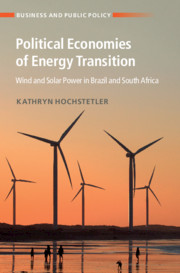Book contents
- Political Economies of Energy Transition
- Business and Public Policy
- Political Economies of Energy Transition
- Copyright page
- Contents
- Figures
- Tables
- Acknowledgments
- Abbreviations
- 1 Political Economies of Energy Transition in Brazil and South Africa
- 2 Wind and Solar Power in the Transition to a Low-Carbon Economy
- 3 States, Markets, and Energy Transition: Good Industrial Policy?
- 4 Electricity Consumption in Brazil and South Africa: Distribution and Prices
- 5 People and Place: Siting Wind and Solar Plants in Brazil and South Africa
- 6 Political Economies of Energy Transition
- References
- Index
5 - People and Place: Siting Wind and Solar Plants in Brazil and South Africa
Published online by Cambridge University Press: 12 November 2020
- Political Economies of Energy Transition
- Business and Public Policy
- Political Economies of Energy Transition
- Copyright page
- Contents
- Figures
- Tables
- Acknowledgments
- Abbreviations
- 1 Political Economies of Energy Transition in Brazil and South Africa
- 2 Wind and Solar Power in the Transition to a Low-Carbon Economy
- 3 States, Markets, and Energy Transition: Good Industrial Policy?
- 4 Electricity Consumption in Brazil and South Africa: Distribution and Prices
- 5 People and Place: Siting Wind and Solar Plants in Brazil and South Africa
- 6 Political Economies of Energy Transition
- References
- Index
Summary
All infrastructure projects need to be placed in particular locations, and host communities typically have local populations, economies, and ecosystems that will be affected. The literature is divided, with energy and economic scholars tending to emphasize local benefits while geographers, anthropologists, and environmental scholars tend to highlight local costs. This chapter examines how local communities in Brazil and South Africa responded to new wind and solar power installations, asking not just about their preferences but also how (and if) they were able to mobilize resources and respond. Environmental impact assessment and land-use policies set a broad framework for these questions. New research conducted for the book finds that communities resisted wind power plants in about a quarter of the 77 Brazilian cities that hosted them, most in Brazil’s poor Northeastern region, especially in an early generation of poorly chosen coastal sites. There was little community protest against solar power in Brazil. South Africa saw little community protest against wind or solar power installations, though national organization BirdLife South Africa did strongly influence siting decisions.
Keywords
- Type
- Chapter
- Information
- Political Economies of Energy TransitionWind and Solar Power in Brazil and South Africa, pp. 175 - 220Publisher: Cambridge University PressPrint publication year: 2020



